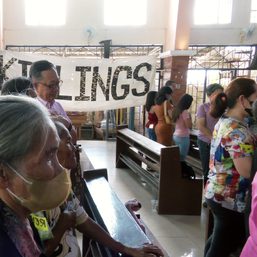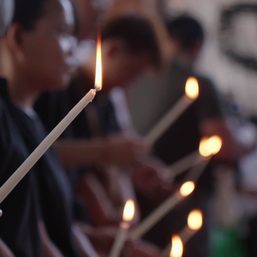SUMMARY
This is AI generated summarization, which may have errors. For context, always refer to the full article.
![[ANALYSIS] 4 million jobless Filipinos, but where is Duterte’s aid?](https://www.rappler.com/tachyon/2021/03/unemployment-and-aid-March-12-2021.jpg)
This week government statisticians told us that in January 2021 the unemployment rate stayed at 8.7%. That’s bad for a couple of reasons.
First, the unemployment rate has stopped dropping even as the economy has started to reopen, and even as quarantine restrictions have loosened up.
Figure 1.
Second, the constant unemployment rate actually translates to 4 million unemployed in January, or 140,590 more than in October 2020. This is because about 1.55 million people came back to participate in the labor force, but not all of them successfully found a job.
Third, the number of unemployed Filipinos is still too high compared to its pre-pandemic level. The nearly 4 million unemployed people in January were 65% more than in January last year, when the pandemic was just gaining ground.
Losing one’s job can be one of the most devastating events in one’s life. Yet amid 4 million unemployed Filipinos, the Duterte government has so far miserably failed to provide enough economic aid. Not because they can’t; they just won’t.
Worse, many Filipinos have learned to accept this sorry state of affairs: they’re not demanding nearly enough the aid they well deserve.
Slow, uneven job recovery
All the new jobs data point to a painfully slow, uneven recovery.
Figure 2 shows that although agriculture jobs have already recovered their pre-pandemic levels, jobs in industry and services are lagging behind.
Some subsectors have fared a lot better than others. In January, the information and communication sector hired 25% more people than a year ago; the health and social work sector 12% more; and the education sector 7% more.
On the opposite side of the spectrum, jobs in hotels and restaurants are still 30% lower than their pre-pandemic levels; jobs in arts, entertainment, and recreation are still 32% lower; and (for some reason) jobs in electricity, gas, steam, and air conditioning supply are still 35% lower.
Figure 2.
Meanwhile, Figure 3 shows that only employers and the self-employed have regained their pre-pandemic job levels. All other types of workers – especially unpaid family workers and wage/salary earners – are having a much harder time doing so.
Figure 3.
Sure, the labor force participation rate inched up to 60.5% in January. That’s comparable to levels seen in 2018 and early 2019 (Figure 4). But that’s still too low for comfort: so long as millions remain outside the labor force, our economy will take a longer time to recover.
Figure 4.
If it’s any consolation, from October 2020 to January 2021 women’s labor force participation rose more than men’s (Figure 5). But until face-to-face classes resume, we can’t expect millions of parents (especially moms) to go back to work just yet. This is an argument for the speedy reopening of schools, to the extent that it can be safely done. (READ: Why we need to safely reopen PH schools as soon as possible)
Figure 5.
Give Filipinos cash aid
For weeks Duterte and his economic managers have been offering a seemingly straightforward solution to the protracted jobs crisis: reopen the economy ASAP. But that plan is being thwarted by an unsettling surge of COVID-19 cases. (READ: The mad, reckless rush to reopen the PH economy)
On March 11, government health officials recorded nearly 4,000 new cases – the highest in almost 6 months. Metro Manila’s mayors have already decided to impose curfews again starting March 15, exactly a year since the initial lockdown. And, rather stupidly (but true to form), the police are going after public displays of affection as though they’re the main culprit for the rise in cases. On top of all this, a nationwide contact tracing protocol bafflingly remains absent to this day.
This feels all too familiar. Once more, government is treating the pandemic as a law enforcement crisis, not a health crisis. They seem to have learned nothing over the past year. We’re back to square one.
Workers, especially the 4 million unemployed, will feel the brunt of the reinstated lockdowns – all the more reason for government to hand out cash aid. (If I sound like a broken record, that’s because this point cannot be said enough.)
Ideally, the Duterte government ought to pass an economic relief measure in the spirit of US President Joe Biden’s massive $1.9-trillion American Rescue Plan, which he already signed on March 11. Among other things, this new law will give millions of Americans $1,400 checks each.
The closest thing Filipinos have is the Bayanihan 3 package now being pushed by Marikina Representative Stella Quimbo (an economist by profession). Worth P420 billion, Bayanihan 3 consists of P52 billion for workers’ wage subsidies, P30 billion for unemployment assistance and cash-for-work programs, and P108 billion for emergency cash transfers (similar to those handed out last year).
It’s a sound measure, one that ought to have been incorporated in the 2021 budget. But although Bayanihan 3 is being sponsored as well by no less than House Speaker Lord Allan Velasco, it’s far from being passed any time soon.
Resistance comes chiefly from Duterte’s economic managers, who see no need for cash injections and instead prefer to stimulate the economy by reopening huge swaths of it as soon as possible.
But doing so will worsen the spread of COVID-19 as surely as a flame grows bigger when you douse it with alcohol. What the economy needs now is not so much stimulus but relief.
Mass vaccination is also key, but that’s proving to be another bottomless well of disappointment and frustration. Government aims to inoculate 70 million Filipinos by year-end, but at the present rate of vaccination that’s now a pipe dream. (READ: Duterte’s vaccine program is peak incompetence)
In February, Duterte formed yet another task force, this time on job creation. But without good pandemic management, a budget for large-scale economic aid, and accelerated vaccination, it’s doubtful whether such a task force will do any good beyond more government PR.
No light at tunnel’s end (yet)
Just as other countries are already talking about “seeing the light at the end of the tunnel,” Filipinos are still talking about curfews, checkpoints, and developing contact tracing protocols like it’s still 2020.
You’d think by now the Duterte government will have seen the necessity of providing enough aid to our people, especially since most economic indicators have gone haywire. But you’d be wrong.
It’s not as if money is the problem. Since last year government has secured at least P641 billion in new loans and grants, partly for the vaccines but mainly for the economy’s recovery. Where is all that money going?
Filipinos deserve aid, but we also need to demand it loudly. At the very least, in 2022 make sure you vote for a government that doesn’t willfully let you starve in times of crisis. – Rappler.com
JC Punongbayan is a PhD candidate and teaching fellow at the UP School of Economics. His views are independent of the views of his affiliations. Follow JC on Twitter (@jcpunongbayan) and Usapang Econ (usapangecon.com).
Add a comment
How does this make you feel?


![[Time Trowel] Evolution and the sneakiness of COVID](https://www.rappler.com/tachyon/2024/02/tl-evolution-covid.jpg?resize=257%2C257&crop=455px%2C0px%2C1080px%2C1080px)





![[Just Saying] Diminished impact of SC Trillanes decision and Trillanes’ remedy](https://www.rappler.com/tachyon/2024/04/Diminished-impact-of-SC-Trillanes-decision-and-remedy.jpg?resize=257%2C257&crop=273px%2C0px%2C720px%2C720px)
![[Rappler Investigates] Son of a gun!](https://www.rappler.com/tachyon/2024/03/newsletter-duterte-quiboloy.jpg?resize=257%2C257&crop=450px%2C0px%2C1080px%2C1080px)
There are no comments yet. Add your comment to start the conversation.